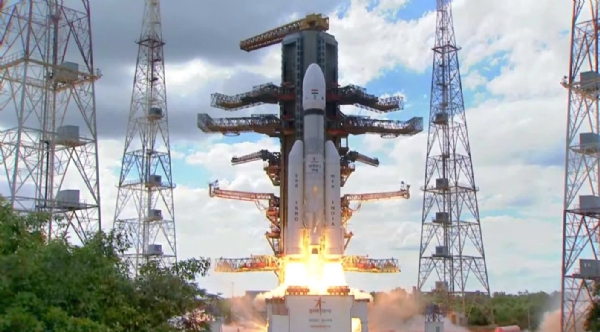En route to creating history! Chandrayaan-3 embarks on its 40-days journey to Moon as it successfully lifts off from Sriharikota station
As Chandrayaan-3 nears the Moon and gets within 100x100 km of the Moon, its landing propulsion module will engage, slowing its descent and fall velocity.
Total Views |
The Indian Space Research Organisation launched its third lunar mission--Chandrayaan 3 on-board the heavylift LVM3-M4 rocket here on Friday.

At the end of the 25.30 hour countdown, the LVM3-M4 rocket, the largest and heaviest in its class and dubbed as 'Fat Boy' lifted off majestically at a prefixed time at 2.35 pm from the second launch pad, discharging thick plumes of smoke.
The propulsion module successfully separated from the rocket just 16 minutes after lift-off. Thousands of spectators who had converged to witness the historic launch cheered the rocket as it made its ascent into the skies.
As Chandrayaan-3 nears the Moon and gets within 100x100 km of the Moon, its landing propulsion module will engage, slowing its descent and fall velocity.
Chandrayaan-3, India’s third lunar exploration mission takes off from Sriharikota,Andhra Pradesh.
— All India Radio News (@airnewsalerts) July 14, 2023
🚀LVM3 Launch Vehicle Mk III takes the Chandrayaan-3 spacecraft to Geo Transfer Orbit (GTO).
🌝#Chandrayaan3 consists of an indigenous propulsion module, lander module, and a rover… pic.twitter.com/pbhxmZO0Eq
The journey from Earth to the moon for the spacecraft is estimated to take about a month and the landing is expected on August 23. Upon landing, it will operate for one lunar day, which is approximately 14 Earth days. One day on the Moon is equal to 14 days on Earth.
The mission follows Chandrayaan-2 where scientists aim to demonstrate various capabilities including reaching the orbit of the moon, making a soft landing on the lunar surface using a lander, and a rover coming out of the lander to study the surface of the moon.
The Chandrayaan-3 will be carrying:
- Radio Anatomy of Moon Bound Hypersensitive ionosphere and Atmosphere (RAMBHA) : It will measure the near surface plasma (ions and electrons) density and its changes with time
- Chandra’s Surface Thermophysical Experiment (ChaSTE) :- It will carry out measurements of thermal properties such as thermal conductivity and temperature of elements on the lunar surface near the south pole.
- Instrument for Lunar Seismic Activity (ILSA) :-It will measure the seismicity around the landing site and describe the structure of the lunar crust and mantle.
- Laser Retroreflector Array (LRA) Rover:- The aim of the LRA Rover, a passive experiment, is to understand the dynamics of the Moon's system.
- Alpha Particle X-Ray Spectrometer (APXS) :- APXS will help determine the elemental composition of the lunar soil and rocks around the landing site. The elements to be studied include magnesium, aluminium, silicon, potassium, calcium, titanium and iron.
- Laser Induced Breakdown Spectroscope (LIBS) Propulsion Module:- LIBS will conduct qualitative and quantitative elemental analysis in order to infer the chemical and mineralogical composition of the lunar surface.
- Spectro-polarimetry of Habitable Planet Earth (SHAPE) :- The function of SHAPE is to study the spectral and polarimetric measurements of Earth from lunar orbit. This means that SHAPE will analyse the spectro-polarimetric signatures of Earth.

